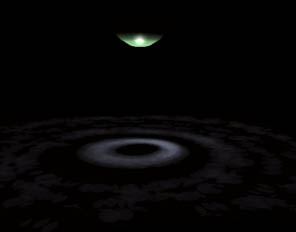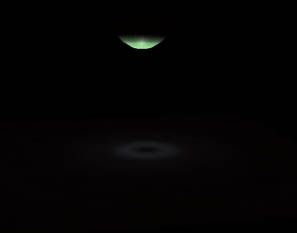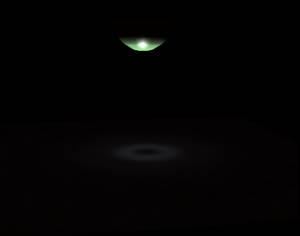3D Animation Workshop: Lesson 94: More Rendering Refinements | 2
|
|
Lesson 94 - More Rendering Refinements - Part 2
Next, we set up for caustics. The hemisphere is made a caustics "transmitter" and the floor is made a caustics "receiver." The spot light is made to emit 10,000 caustic photons. The renderer is told to compute caustics, but not global illumination (meaning diffuse reflection) because we want to explore the caustic effects alone. The rendered result shows the highlight on the ball reflected onto the floor as a ring of light.

This first test uses the default number of photons, so it's wise to try some other values. I increased the photon count to 100,000. You may remember from the previous lesson how more photons produced a smoother result in global illumination. But in this case, the greater resolution generates an artificial and unsatisfactory pattern.

How about using fewer photons? Maybe a lower resolution will look better. But the result using only 1,000 photons is sloppy and produces large concentric rings.

The number of photons defines the amount of caustic information available in the scene. Another parameter, called Accuracy, determines the number of photons that will be considered when drawing an individual pixel. The default is 100. I returned to the original 10,000 total photons, but increased the Accuracy to 500. This produced a slight improvement over the first render.

Using these values, I experimented to see how changing the specular "spread" of the object material affected the caustic effect. It didn't. A much wider specular region on the hemisphere does not alter the reflection on the floor.

On the other hand, changing the intensity of the specularity does modulate the caustic effect. Note the decreased specular highlight on the hemisphere, and the resulting decreased reflection on the floor.

You can also decrease the amount of caustic "energy" allocated to the photons. I brought the specular intensity of the hemisphere back up to its original value, but reduced the caustic energy associated with the spot light. The reflection on the floor remains soft, even though the highlights on the hemisphere are once again bright.

| To Continue to Part 3, or Return to Part 1, Use Arrow Buttons |
|
Created: June 6, 2000
Revised: June 6, 2000
URL: https://webreference.com/3d/lesson94/2.html


 Find a programming school near you
Find a programming school near you